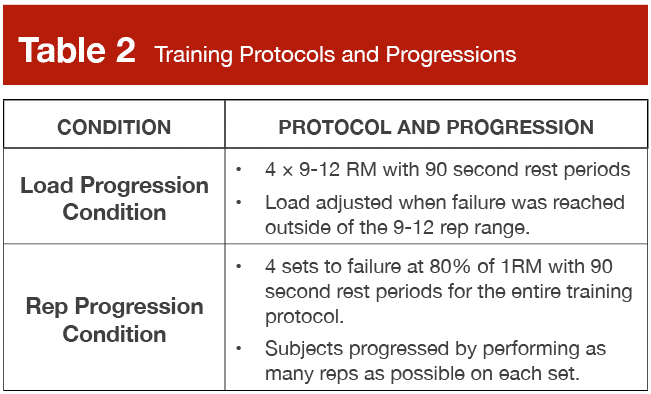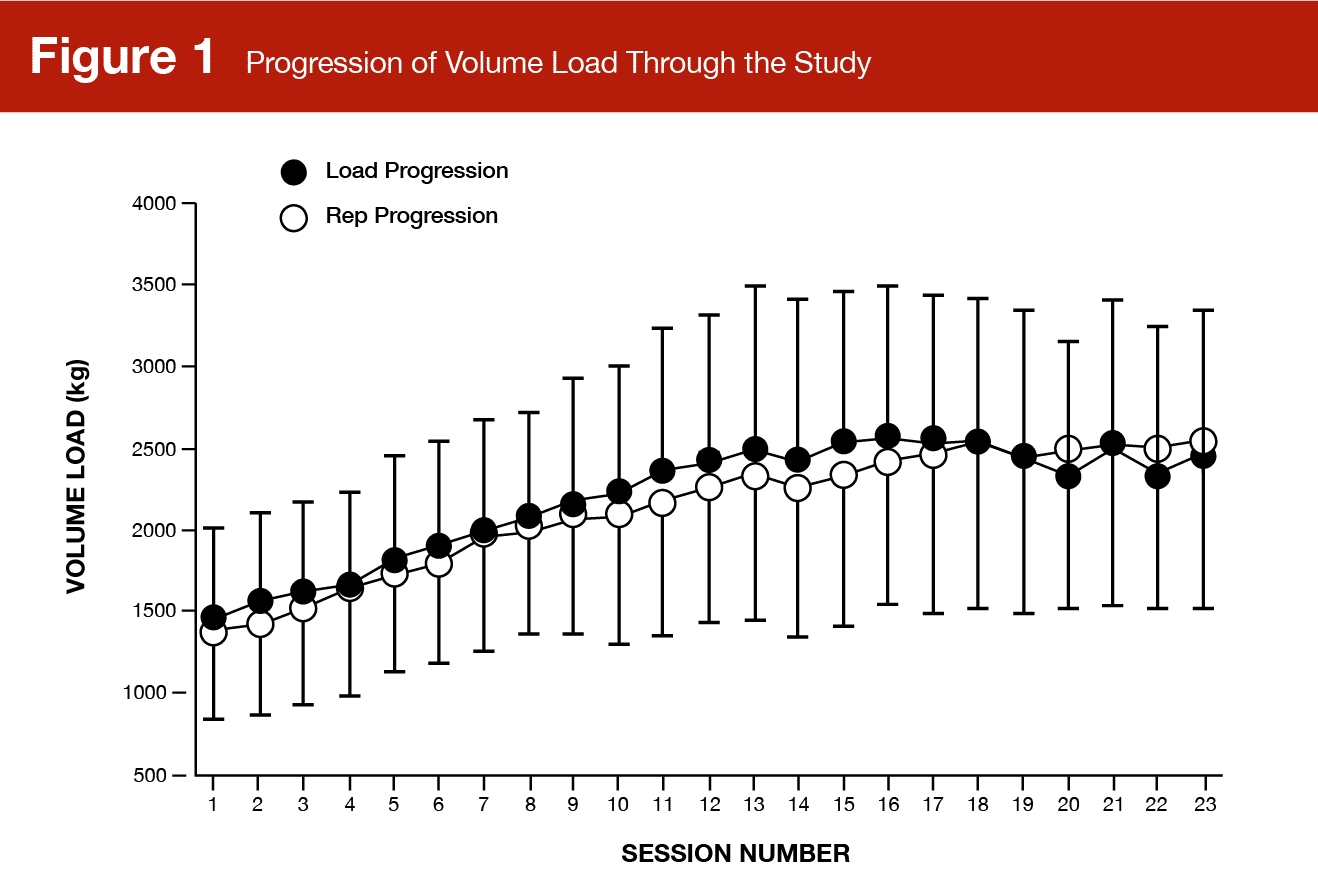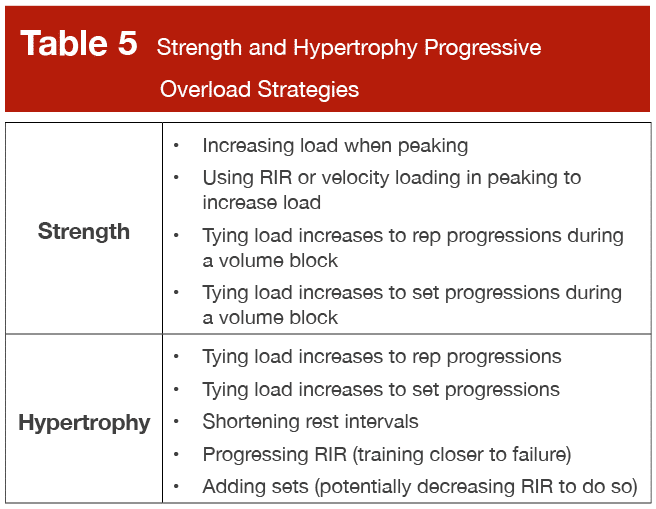Notice: This text was the MASS Analysis Overview cowl story for April 2024 and is a evaluation of a recent study by Chaves et al. If you would like extra content material like this, subscribe to MASS.
Key Factors
- Ladies and men did unilateral leg extensions 2-3 instances per week for 10 weeks. The themes elevated the load lifted as wanted on one leg and elevated the variety of reps per set on the opposite leg.
- The researchers discovered that each strategies of progressive overload led to important will increase in leg extension 1RM and vastus lateralis cross-sectional space. There have been no important variations within the pre- to post-study adjustments between circumstances.
- Numerous progressive overload methods can maximize short-term good points in novice trainees. In additional educated people, particularly these aiming to maximise energy, load development is crucial. Moreover, selecting between growing load or reps just isn’t a binary selection; these progressive overload methods can be utilized at the side of one another.
Each week for years, I stared at my coaching spreadsheet, agonizing over the best way to obtain progressive overload. Ought to I improve the load? Ought to I improve the reps? Ought to I add units? Ought to I shorten the size of the remaining interval? Ought to I elevate the identical weight however accomplish that with my hat backward to make sure I set a brand new private document? Typically I might agonize a lot over these particulars that I’d attempt to implement all of them into one coaching block, which was a surefire strategy to overcomplicate issues (professional tip: even when it’s not “optimum,” decide a technique, consider in it, and keep it up for not less than a bit bit). Regardless of my earlier indecision, these are all equally authentic methods to attain progressive overload or to set a PR (nicely, possibly not the hat adjustment). However is one higher than the opposite?
A earlier between-subjects research by Plotkin et al (2 – MASS Review) discovered that educated men and women had improved energy and muscle measurement to a (principally) related extent when evaluating load and rep development. Nevertheless, energy good points might have been barely larger (+5.9%) with load development compared to rep development. That research recruited educated people however examined energy on a Smith machine, even supposing contributors had been extra accustomed to the free-weight squat. Thus, these outcomes can’t be completely extrapolated to different populations or to “particular energy” (testing energy on the educated train). Moreover, one research is hardly going to discourage people from agonizing over the best way to greatest progress coaching to maximise muscle progress. Fortuitously, a brand new within-subjects design research by Chaves et al (1) as soon as once more in contrast load and rep progressions for energy and hypertrophy in a mixed-sex inhabitants, however this time they examined particular energy.
Function and Hypotheses
Function
The first objective of the reviewed research was to match adjustments in leg extension 1RM and vastus lateralis cross-sectional space over 10 weeks of coaching that progressed both the load lifted or reps carried out in untrained women and men.
Hypotheses
The researchers hypothesized that load development would result in larger will increase in each energy and muscle measurement than quantity development. They anticipated that load development would result in larger adjustments within the quantity load (units × reps × load lifted) over time, which might in the end translate to larger good points in energy and measurement.
Topics and Strategies
Topics
Thirty-nine girls (n = 19) and males (n = 20) who had not carried out resistance or cardio coaching for not less than six months participated within the research. Extra traits of the topics are introduced in Desk 1.

Research Overview and Coaching Protocols
The researchers used a longitudinal within-subjects design wherein all topics accomplished every coaching situation. Particularly, over the course of 10 weeks, all topics carried out unilateral leg extension coaching and achieved progressive overload on one leg by growing the load whereas they elevated the reps all through the research on the opposite leg. Topics educated each legs two to 3 instances per week for a complete of 23 coaching classes. The condition-specific protocols and development schemes are introduced in Desk 2.


Outcomes
Researchers assessed vastus lateralis cross-sectional space by way of ultrasonography and leg extension 1RM earlier than and after the 10-week coaching intervention. Researchers additionally in contrast the load lifted (absolute and % of 1RM), variety of reps carried out, and quantity load between the circumstances.
Findings
General Findings
The researchers discovered that the topics considerably elevated each energy and cross-sectional space (p < 0.0001). There was no important situation × time interplay for adjustments in both energy (p = 0.20) or cross-sectional space (p > 0.87; Desk 3). Moreover, there was no important distinction in quantity load development between the coaching circumstances (p = 0.19; Determine 1).




The one important variations that existed had been immediately associated to review design selections. Particularly, the topics lifted heavier masses within the load development situation (p < 0.001; Desk 4) and carried out 292 extra reps within the rep development protocol (1292 ± 302 versus 1000 ± 67 reps; p < 0.001).


Interpretation
The presently reviewed research from Chaves et al (1) discovered that reaching progressive overload by growing load or growing reps led to related good points in leg extension 1RM and quad hypertrophy. One other current research by Plotkin et al (2 – MASS Review) additionally in contrast load and rep development and located related outcomes. This interpretation compares these two research and discusses the conditions wherein the particular technique of progressive overload might matter.
Comparability of Chaves et al (1) and Plotkin et al (2)
On the floor, the protocols in each research and the findings from each research (1, 2) had been related, however essential variations existed. Concerning the similarities, Plotkin et al (2) used a virtually equivalent protocol that consisted of a load development group beginning with 4 × 8-12RM (9-12 RM was used within the current research), and the load was elevated when failure was reached exterior of the goal rep vary. Plotkin et al had the rep development group full 4 units to failure with a 10RM every session and elevated reps as they may, which was equivalent to the current research. Moreover, each research reported that group-level good points in energy and muscle tended to be related between development protocols. Nevertheless, Plotkin et al reported that energy elevated “barely” extra (+5.9%) within the load development group, and that the rep development group skilled a 1.8% larger change within the sum of all rectus femoris web site muscle thicknesses. Due to this fact, it’s crucial to debate methodological variations to find out why there might have been barely totally different findings and what this implies for the lifter. The three methodological variations to debate are: 1) coaching standing of the topics, 2) train choice, and three) the research design.
The very first thing to contemplate is whether or not the share variations in favor of load (energy) and rep (hypertrophy) development in Plotkin et al (2) are actual variations. I believe there may be advantage to say that people usually gained extra energy from load development in Plotkin et al’s research, however in all probability not sufficient advantage to say that rep development was superior for hypertrophy. Within the presently reviewed research from Chaves et al (1), there was basically no distinction on the group degree (+1.4% in favor of load development) for leg extension 1RM when progressing load. Though load is clearly the first driver of energy good points (3), the topics within the present research had been both untrained or had not educated for not less than six months, whereas these in Plotkin et al had educated for almost 4 years, on common. Though load might play a task in energy achieve for untrained contributors, it appears to matter extra for educated people (3). Moreover, Glass et al (4 – MASS Review) noticed strong energy good points in untrained people who used solely ~40-60% of 1RM. Due to this fact, it’s attainable that the novice coaching standing of topics within the presently reviewed research explains the dearth of between-condition variations in energy good points.
Chaves et al (1) had contributors prepare a low-skilled motion, the leg extension, whereas Plotkin et al (2) utilized the free-weight again squat for coaching classes. It’s attainable that the topics in Plotkin et al skilled enhanced energy advantages due using a extremely expert free-weight train. Apparently, Plotkin et al really examined energy on the Smith machine squat regardless of coaching with a free-weight squat; nevertheless, it’s attainable that the Smith machine squat was related sufficient to the free-weight squat in order that heavier loading in coaching for the load development group was extra useful. I’m a bit torn on whether or not or not I actually assume coaching the free-weight squat with heavier loading was extra useful for Smith machine energy, so I might in all probability lean extra into the coaching standing argument to clarify the possibly larger energy good points in Plotkin et al.
Lastly, the Plotkin et al (2) research had a between-subjects design, whereas the current research by Chaves et al (1) had a within-subjects design. I’ve previously written about the variations between these two research designs in larger depth. In short, a between-subjects research, corresponding to Plotkin et al, compares two teams of topics, wherein one group performs one coaching program and the opposite group performs a distinct coaching program. Importantly, the person response to coaching is very variable (5), and this design doesn’t enable the researcher to find out how a person would reply to the opposite protocol. Due to this fact, in an underpowered research (which is many, if not most, coaching research), if one group had considerably larger good points than one other group, on common, it’s attainable that many in a single group didn’t reply nicely to that protocol relatively than the protocol itself being inferior for everybody. For instance, within the research by Plotkin et al, the vary of improve in Smith squat 1RM was +5.8-55.7 kg (load development group) and +4.0-33.2 (rep development group); thus, we have no idea if some people would have responded higher or worse within the reverse protocol. In distinction, Chaves et al (1) used a within-subjects design. Sadly, Chaves et al didn’t report particular person topic information; subsequently, we nonetheless have no idea how people responded to every protocol. Nevertheless, the variations between teams for energy good points (1.2%) and muscle progress (0.6%) had been very small; thus, it might be shocking if there have been massive variations in within-individual charges of progress.
It also needs to be famous that whereas a within-subjects design does enable us to look at how a person responds to each protocols, there is a vital limitation of this design because it pertains to energy good points. Particularly, coaching one limb will result in the “cross-education” impact, which is the advance in energy of the other limb that’s educated (6). Whereas I wrote about this in depth here, information present that if people prepare one limb and never the opposite they may improve energy about 7-10% within the untrained limb, on common, in 4-12 weeks when coaching with ≥60% of 1RM (7, 8). Due to this fact, it’s attainable within the presently reviewed research that the advantages of elevated loading within the load development group had been additionally realized within the rep development group, which explains the dearth of between-condition distinction in energy good points. To be clear, I don’t assume that’s why the energy good points had been so shut (1.2% distinction) between teams, but it surely’s attainable that the cross-education impact dampened the distinction, even when to a trivial diploma. Importantly, coaching one limb is not going to improve muscle measurement within the different limb; thus, the cross-education impact doesn’t manifest for hypertrophy.
In actuality, the findings of the 2 research had been fairly related. It’s price reiterating that Plotkin et al (2) didn’t discover that there have been true variations between teams for energy good points, relatively the purpose estimate for energy good points “barely” favored the load development. Moreover, related hypertrophy between teams is no surprise, as the present research discovered that quantity load and quantity load development weren’t considerably totally different between teams, and each research had been set-equated between the load and rep development protocols.
Particular Conditions Dictating Progressive Overload Type
After I reviewed the aforementioned research by Plotkin et al (2) in Volume 6, Issue 12, I mentioned many various methods to attain progressive overload, and the way these totally different methods may very well be intertwined. There may be not a lot sense in a complete rehashing of these particulars, since you’ll be able to merely click here and browse that article. In short, the load may very well be progressed based mostly on a predetermined proportion or absolute loading change, a earlier session RIR or velocity, or by plus set efficiency to call a couple of. Moreover, the load, rep, and set progressions aren’t mutually unique and might be intertwined. For instance, this table demonstrates how the load is barely elevated after a lifter can carry out a sure variety of units with a given load, illustrating how the load is barely elevated after a sure variety of reps are achieved with that given load. Now that we’re conscious of all these progressive overload methods, let’s focus on when totally different methods is likely to be preferable.
Allow us to start with development when energy is the first objective. Clearly, load development is an important and non-negotiable kind of development that should happen to maximise 1RM energy over the lengthy flip. Nevertheless, does load development must occur on a regular basis? The reply is a transparent “no.” For instance, a powerlifter can use a easy mannequin wherein they improve the load by 2.5 kg every week as they strategy competitors, in the end reaching heavy masses (i.e., ≥90% of 1RM); nevertheless, they might not be capable of progress load every week, wherein case they need to not pressure it. In these conditions, it might be higher so as to add a further set or rep after which improve the load the next week. Alternatively, the lifter might autoregulate the coaching load from week-to-week when peaking for a powerlifting meet or gymnasium take a look at day; thus, they might solely improve the load after they had been capable of. For instance, a lifter might program 3 × 2 @1-2 RIR and would elevate no matter load they may do for 2 reps in that RIR vary, which might generally be heavier, lighter, and even the identical in comparison with the earlier week’s coaching.
Furthermore, somebody with energy as their principal objective will nonetheless carry out quantity blocks sometimes, wherein muscle progress is focused. In these conditions, there isn’t any strain to extend the load, not less than not every week. Due to this fact, intertwining load with rep or set benchmarks is an efficient technique. As seen here, a lifter may very well be prescribed a set and RIR benchmark wherein the load solely progressed as soon as the benchmark was reached. For instance, a lifter may very well be prescribed squats with 3 × 8 with 100kg and add a set every week so long as they full all units at ≥2 RIR. Then, as soon as they had been capable of carry out 5 × 8 at 2 RIR they might improve the load. Alternatively, a strength-focused particular person in a quantity block might tie load will increase to a rep benchmark. In quantity blocks, people targeted on energy might make the most of programming methods, corresponding to rest-pause coaching, which have progressive overload built-in by making an attempt to carry out extra reps every time the technique is used.
I’ve been on document saying that coaching for muscle progress is much more forgiving than coaching for energy. In fact, the 2 (hypertrophy and energy) are interrelated, but when energy is the primary goal, then load development is a should sooner or later, periodization appears to matter (9 – MASS Review), and a lifter should apply the particular train with which they’ll take a look at their energy (i.e., a powerlifter should carry out the squat, bench press, and deadlift). Whereas there are some “guidelines” for hypertrophy corresponding to extra quantity (to some extent) drives muscle progress and the person ought to have sufficient exercise variety, conventional (energy targeted) fashions of periodization don’t appear to matter (9) and progressive overload might be achieved by means of numerous strategies. A person can use rep or set development fashions as described above. The lifter may manipulate RIR all through the course of a coaching block to attain progressive overload. Particularly, a lifter might maintain the variety of units fixed and improve the load in order that the RIR decreases from week-to-week to coach nearer to failure. Alternatively, a lifter might select to take care of the identical load and add units every week in the course of the coaching block. On this state of affairs, the RIR may really improve, however the improve in RIR (coaching farther from failure) may make it extra possible for the lifter so as to add a number of further units. Yet one more technique may very well be for the lifter to shorten curiosity relaxation intervals to make every set harder. This time-saving technique may enable the lifter so as to add an additional set. To be clear, I’m not saying that anyone technique is any extra fascinating than one other; relatively, I’m simply presenting numerous choices. Desk 5 summarizes the suitable progressive overload methods for each energy and hypertrophy.


Coach’s Nook
Let’s end up with a “coach’s nook” part to debate sensible factors for coaches and lifters when placing progressive overload into motion.
First, lifters will not be capable of progress each session or week, and anybody who has educated for a considerable period of time is aware of this. Due to this fact, since you recognize this, don’t pressure development each week and check out your greatest (though I do know it’s robust) to not get pissed off if you’re lifting the identical load for a few weeks in a row. Recall that the objective is progressing over time. The objective is to not improve the load (or set or reps) for its personal sake. Saying “I did 40 units of quads this week” shouldn’t be a badge of honor (though it’s sort of superior). If that’s enjoyable, by all means, go for it. Nevertheless, if the objective is to maximise energy or attempt for the perfect aesthetics then don’t chase the set, rep, or load quantity, chase the energy or physique progress, which might generally come from being disciplined sufficient to not progress variables throughout a single week.
Secondly, don’t get paralyzed whereas deciding which progressive overload technique to make use of. The entire methods talked about on this article have deserves. Discover one which applies to your objectives and keep it up for a whole coaching block. As a coach and lifter, I’ve agonized many instances over what actual technique to make use of for myself or for numerous athletes. Usually, I’m higher at selecting a way for others, however for myself, I might typically attempt to combine too many various ideas, mitigating their effectiveness or dropping deal with the primary objective (progress). My warning is to keep away from this lure and discover a logical progressive overload technique that’s applicable for you (or your shopper’s) objectives and keep it up for an honest time frame.
Subsequent Steps
In my evaluation of Plotkin et al (2), I known as for a brand new research evaluating load versus rep development, however with a free-weight train utilized in each coaching and testing. The presently reviewed research was addition to the literature for the hypertrophy outcomes as a result of it was a within-subjects design. For energy outcomes, it’s attainable that the cross-education impact confounded the outcomes, though I doubt to a really significant diploma. Moreover, in a within-subjects design actions corresponding to squats and bench presses can’t be used. Due to this fact, I’ll once more counsel that the following step could be to match load versus rep progressions in educated people utilizing a free-weight squat or bench press as each coaching and testing workout routines.
Software and Takeaways
Chaves et al (1) discovered that over 10 weeks, untrained people skilled related energy good points and hypertrophy no matter whether or not they achieved progressive overload by growing the load or the variety of reps, though we needs to be cognizant that the cross-education impact might have confounded the energy findings. Nevertheless, the dearth of variations between coaching protocols on this research doesn’t imply that the strategy of progressive overload is at all times immaterial. On the whole, these focused on energy should improve their load at instances, particularly within the coaching block instantly previous a energy competitors (e.g., powerlifting meet) or 1RM take a look at day. When muscle progress is the primary objective, lifters have rather more flexibility to attain progressive overload by way of load and/or repetition changes. In the end, progressive overload methods might be intertwined and coaches and lifters mustn’t contemplate themselves sure to the binary selection of load or rep development.
Get extra articles like this
This text was the duvet story for the April 2024 problem of MASS Analysis Overview. Should you’d prefer to learn the total April problem (and dive into the MASS archives), you’ll be able to subscribe to MASS here.
Subscribers get a brand new version of MASS every month. Every problem contains analysis evaluation articles, video displays, and audio summaries. PDF points are normally round 100 pages lengthy.
References
- Chaves TS, Scarpelli MC, Bergamasco JG, da Silva DG, Junior RA, Dias NF, Bittencourt D, Carello Filho PC, Angleri V, Nóbrega SR, Roberts MD. Effects of resistance training overload progression protocols on strength and muscle mass. Worldwide Journal of Sports activities Drugs. 2024 Jan 29.
- Plotkin D, Coleman M, Van Each D, Maldonado J, Oberlin D, Israetel M, Feather J, Alto A, Vigotsky AD, Schoenfeld BJ. Progressive overload without progressing load? The effects of load or repetition progression on muscular adaptations. PeerJ. 2022 Sep 30;10:e14142.
- Lopez P, Radaelli R, Taaffe DR, Newton RU, Galvão DA, Trajano GS, Teodoro JL, Kraemer WJ, Häkkinen Okay, Pinto RS. Resistance training load effects on muscle hypertrophy and strength gain: Systematic review and network meta-analysis. Drugs and science in sports activities and train. 2021 Jun;53(6):1206.
- Glass SC, Ahmad S, Gabler T. Effectiveness of a 2-week strength training learning intervention on self-selected weight-training intensity. The Journal of Power & Conditioning Analysis. 2020 Sep 1;34(9):2443-8.
- Hubal MJ, Gordish-Dressman HE, Thompson PD, Value TB, Hoffman EP, Angelopoulos TJ, Gordon PM, Moyna NM, Pescatello LS, Visich PS, Zoeller RF. Variability in muscle size and strength gain after unilateral resistance training. Drugs & science in sports activities & train. 2005 Jun 1;37(6):964-72.
- Ruddy KL, Carson RG. Neural pathways mediating cross education of motor function. Frontiers in human neuroscience. 2013 Jul 29;7:397.
- Farinas J, Mayo X, Giraldez-García MA, Carballeira E, Fernandez-Del-Olmo M, Rial-Vazquez J, Kingsley JD, Iglesias-Soler E. Set configuration in strength training programs modulates the cross education phenomenon. The Journal of Power & Conditioning Analysis. 2021 Sep 1;35(9):2414-20.
- Manca A, Dragone D, Dvir Z, Deriu F. Cross-education of muscular strength following unilateral resistance training: a meta-analysis. European journal of utilized physiology. 2017 Nov 1;117(11):2335-54.
- Moesgaard L, Beck MM, Christiansen L, Aagaard P, Lundbye-Jensen J. Effects of periodization on strength and muscle hypertrophy in volume-equated resistance training programs: a systematic review and meta-analysis. Sports activities Drugs. 2022 Jul;52(7):1647-66.
